Abstract
Transport has an important role since the earliest periods of human history when certain routes were used for trade between different regions of the globe leading to the development of culture, spreading ideas and establishing strategic partnerships. The role of transport is extremely important for regional, national and world economic development because it stimulates the growth of other industries by creating the premises of a harmonious progress. Lately it can be noted an increase in air and road transport sector worldwide and this trend can be identified even in Romania. By 1990 the transport sector in Romania was totally controlled by the state, as otherwise the entire Romanian economy. Starting that year began appearing private initiatives to meet the needs of people who had to travel to other destinations. This paper aims to identify the effects of private air and road transports market growth in Romania.
Keywords: Air transportationroad transportationprivate investmentseconomic developmentconsumer choice
1Introduction
Transport has an important role in the national economy. Land transport gross value added in 2011
was 23.6783 billion lei current prices, so the employment in the whole sector reached 433 thousand in
2012 and net investments in the same year were 5.5619 billion lei current prices. The effects of
switching from 1990 until now from the planned economy to the market economy are meant to be
analyzed in this paper. The role of the state in the transport sector need special consideration in the
current economic context, which is characterized by the economic crisis consequences. We believe that
capturing the effects of privatization on various transport markets has great importance in order to
improve transport services with benefits that will be transmitted across national economy. These effects
can lead to increased foreign direct investment, tourism development with its multiplier effects and
improve the competitiveness of Romania.
Thereby, an important aspect that was mentioned in "The International Encyclopedia of business
and management: vol. 5: Privatization and regulation" (Warner, 1996: 78-85) concerning the
organization and management of public institutions, consists of the issue of liability. The Public Sector
Management presents the following paradox - on the one hand, critics see it as being characterized by
professional groups lacking accountability, on the other hand, professionals and managers in the public
sector will justify bureaucracy by the need to demonstrate political superiority in relation to the press
and the public fairness of the proceedings conducted. When adopting or experimenting with new
approaches, there is a danger that they be incorporated into a bureaucratic approach. The Public sector
management has a great need for legitimacy in comparison with the private sector. Finally, the source
of legitimacy lies in the democratic accountability of the public sector, but it raises issues, as
democratic legitimacy is a matter of interpretation of the competition policy and it is subjected to
various political agendas.
There are authors who believe that with the changes of the post-industrial society until the
cyberspace era, it has become increasingly difficult for governments to adapt and respond to changes at
the pace desired by citizens (Sinclair, 2006: 92-106). In his "Stealth KM winning knowledge
management strategies for the public sector," Niall Sinclair believes that they should find a level of
change that is appropriate with regards to time constraints and resources, both human and financial.
From his point of view, there is an urgent need for governments to prepare for the retention and
dissemination of knowledge, as the current generations of public servants make room for new ones.
The author presents a series of case studies in which by using knowledge management models of
public-sector, activity is being improved. It is worth recalling the case of the Federal Aviation
Administration in the US, which is the responsible institution for civil aviation safety in the United
States. The purpose of implementing knowledge management models was the need to streamline
business processes and the solution applied in this case is called - Network for knowledge. The
implementation of this model followed several steps that ultimately led to an increase in efficiency.
The issue of the role of subsidies for the public transport services is discussed by Hensher and Brewer
(2001: 123-144) in "Transport - an economic and management perspectives." The two believe that despite
the fact that privatization and deregulation contribute to the economic development organization's ability
to efficiently manage their costs and set prices that ensure an efficient allocation of resources, there is
justification for providing subsidies. The justification is based on the obligation to provide a specific level
of service and it cannot be guaranteed by the forces of commercial activity in a competitive market.
Investigations about how the ownership affects the productivity of firms operating in the local
public transport, shows that total or partial public firms have lower productivity than privately owned
firms (Boitani et al 2013: 1419–1434). The authors conducted a comparative analysis of 77 firms form
large European cities over the period 1997 to 2006. Their results are in favor of the idea that private
shareholders are correlated with higher productivity. Researchers say that this is because private
shareholders have stronger incentives in order to make the firms more efficient and due to the fact that
after the privatization process, they only remain productive firms.
Button and McDougall (2006) concludes that despite privatization of the airline industry safety
conditions have improved over time on core markets.
Hooper (2002) believes that by holding majority control of state enterprises risk losing the benefits
of privatization. The author considers that the most successful examples of airport privatization around
the world are those in which the institutional framework is well developed and the political risk factor
is reduced. In spite of this argument there are researchers which believe that in a competitive setting,
public and fully private airports operate efficiently, but private airports still charge higher aeronautical
fares (Adler et al., 2014). Other research (Itani et al., 2015) has shown that private airports are more
effective than those controlled by the state, which are even less effective than those with mixed
ownership.
There is research that points out that the existence of regulatory weak institutions coupled with
mismanaged privatization programs have ended in private monopolies, low economic growth, uneven
social development, political instability, an alarming increase in insecurity and social unrest (Vargas-
Hernández, 2010).
2Data and methodology
The Data that is analyzed in this paper are taken from the site of the National Statistics Institute
(INSSE). The correlation of indicators of development of road and air transport in relation to the degree
of privatization indicators will be tested and the present paper will also apply econometric and
statistical methods such as correlation and regression coefficient.
The regression method is relying on the measurement and the prediction of the influence exerted by
one or more factors (the exogenous variable – cause X) on a certain indicator (endogenous variable –
effect Y). The basic element in regression is the regression function, which presents the dependency of
the Y variable on the X variable factor (Zaharia et al. 2010). The regression function can be validated
by the dispersion analysis which is calculed by the F test (Fisher Snedecor). The regression model is
statistically significant if calculated F is greater than critical F. Also, the model can be considered
statistically significant if Significance F is lower than α, where α represents the significance threshold
and 1 – α represents the confidence level. Usually, α=0.05 or α= 0.01, corresponding to a confidence
level of 95% and 99%.
Thus, the first couple of indicators analyzed are represented by the number of passengers and the
number of private enterprises in the road transport market. We will assess the way in which the number
of passengers has been influenced by the evolution of the number of private enterprises, in the period
1998-2013.
The dynamics of the two indicators show fluctuations throughout the period under review.
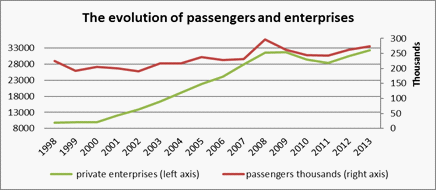
Considering the evolution of passengers and the number of private enterprises in Romania between 1998 and 2013, the following correlogram of both indicators has been carried out (Figure
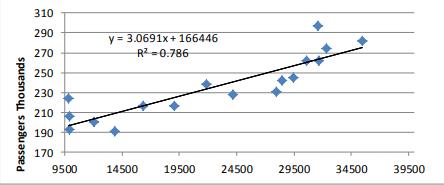
It is worth mentioning that the determination degree between the two indicators is 0.786, which
means that the number of passengers is 79% influenced by private enterprises; the relationship between
them is very strong. The correlation coefficient between these indicators is 0.88 which means that there
is a strong positive relationship.
The second and last pair of analysed indicators is the one formed by the number of passengers and
the number of aircraft in the air transport market between 1997 and 2014. These indicators were
selected because we believe that the number of aircrafts fully expresses the involvement of private
agents in this market; this involvement can be correlated with the number of passengers who choose
this type of transportation.
It is observed that the number of passengers has an upward trend throughout the analysed period.
The dynamics are reduced in 2009, probably due to the economic crisis whose effects are felt by the
consumers of the transport services. The second indicator - the number of aircraft, recorded some
fluctuations in the first 7 years. Since 2004 and until 2010, the number of aircrafts increases, reaching a
maximum value of 89 aircrafts in 2010. After this year, the growth trend reverses.
In order to better notice the relationship between the two indicators, the present study carries out a
correlogram (Figure
aircrafts of 86%.
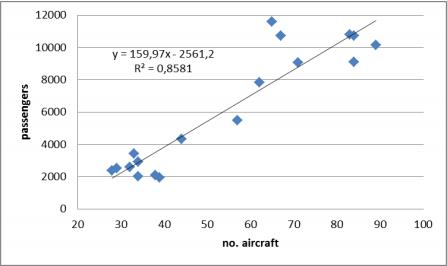
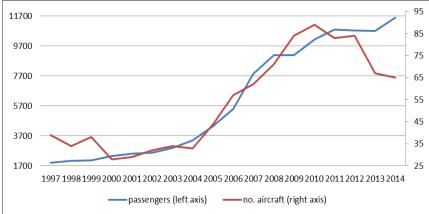
Furthermore, the present study will analyse the data by using the spreadsheet software and the results will be presented below (table no. 3).
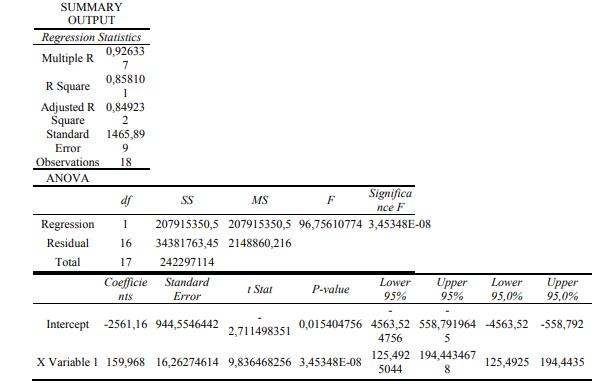
The correlation ratio is 0.926, which shows us that there is a strong relationship between the number
of aircrafts and the number of passengers. The percentage used by the number of aircrafts to influence
passengers is approximately 86% (R Square = 0.8581). Due to the fact that the significance threshold is
lower than 0.05 (Significance F = 0.0000000345 < 0.05), the regression model is valid. The model was testing for 0.05. The correlation coefficient between these indicators is 0.93, which means that
there is a strong positive relationship. The model is:
yˆ = -747.603 + 40.138 ∙ x (1)
In equation (1) yˆ represents the number of passengers (expressed in thousands) and x represents
number of aircraft. As ta=-2,711 and significant level (P-value) is 0,0154<0.05, it means that the
coefficient is statistically significant, considering that fact that the coefficient is taking values between
the lower (Lower 95%) and upper limit (Upper 95%) of -4563,524 to -558,7919.
The number of aircrafts coefficient (159,968) indicates that the average number of aircraft increased
with 1 unit and the number of passengers increased by about 15996 visitors. Since tb = 9,83646 and P-
value is 0.000000034<0.05, the coefficient is statistically significant. Confidence interval ranges from
the lower limit (Lower 95%) and upper limit (Upper 95%) of 125,49 to 194,44.
3Conclusion
The evolution of the passenger road transport is strong influenced by the number of companies in
the sector. The quality of the means of transportation may prove more important in consumers’ along
with the generous offers. Another factor that influenced these results may be the migration of
passengers from rail to road transport which has the advantage of high accessibility, but also of better
starting hourly versus rail. The effects of private investment in the aviation sector are well reflected in
the number of passengers who decide to use this mode of transport. Increasing the number of travelers
from 2012 despite the decrease in the number of aircraft can be explained by increasing the frequency
of flights operated by airlines, but also by increasing occupancy or by replace old aircraft with others
that have a higher transport capacity. These results are of great importance for the national economy, it
can represent a strong argument for stimulating private investment in both these sectors and also in
markets such as rail and maritime transport. This stimulation can be promoted by lowering the tax
burden, and by removing barriers to entry, so that private investors can easier capitalize on any
opportunities that exist. The performed analyses should be interpreted with caution due to the impact of
the economic crisis results. Because of that, future investigations are necessary in order to analyze the
effects before and after the appearance of the economic crisis. The limitations of this study can be
expressed by the fact that data on the number of road transport enterprises are not shared between
public and private, so you cannot see exactly how the observed effects are due to the privatization itself
and how much is due to the foundation of the new enterprise. By considering these limitations, it can
be argued that the role of private enterprises in the two transport markets analyzed is important; its
effects can be seen in the increasing number of passengers.
References
- Adler, N., Liebert, V. (2014). Joint impact of competition, ownership form and economic regulation on airport performance and pricing. Transportation Research Part A, 64, 92-109.
- Boitani, A., Nicolini, M., & Scarpa, C. (2013). Do competition and ownership matter? Evidence from local public transport in Europe. Applied Economics, 45, 1419–1434.
- Button, K., McDougall, G. (2006). Institutional and structure changes in air navigation service-providing organizations. Journal of Air Transport Management, 12(5), 236-252.
- Hensher, D., Brewer, A. (2001). Transport: an economic and management perspective. Oxford: Oxford University Press.
- Hooper, P. (2002). Privatization of airports in Asia. Journal of Air Transport Management, 8, 289-300.
- Itani, N., O'Connell, J.F., Mason, K. (2015). Towards realizing best-in-class civil aviation strategy scenarios. Transport Policy, 43, 42-54.
- Sinclair, N. (2006). Stealth KM: winning knowledge management strategies for the public sector. Amsterdam: Elsevier.
- Vargas-Hernández, J. G. (2010). From 'entrepreneurial state' to 'state of entrepreneurs': Ownership implications of the transformation in Mexican governance since 1982. International Journal of Public Policy, 5(1), 57-73. Warner, M. (1996). International encyclopedia of business and management: vol. 5: Privatization and regulation. London: Routledge.
- Zaharia, M., Gogonea, M., Oprea, C. (2010). Econometric analysis of the flow of tourists in the accommodation structures in Romania. The Annals of "Ştefan cel Mare" University of Suceava, 10 (Special Number), 92-100.
Copyright information

This work is licensed under a Creative Commons Attribution-NonCommercial-NoDerivatives 4.0 International License.
About this article
Publication Date
04 October 2016
Article Doi
eBook ISBN
978-1-80296-014-3
Publisher
Future Academy
Volume
15
Print ISBN (optional)
-
Edition Number
1st Edition
Pages
1-1115
Subjects
Communication, communication studies, social interaction, moral purpose of education, social purpose of education
Cite this article as:
Păun, I. G. (2016). Private Development of Road and Air Transport Market from Romania – Implications for the Economy. In A. Sandu, T. Ciulei, & A. Frunza (Eds.), Logos Universality Mentality Education Novelty, vol 15. European Proceedings of Social and Behavioural Sciences (pp. 702-709). Future Academy. https://doi.org/10.15405/epsbs.2016.09.89

